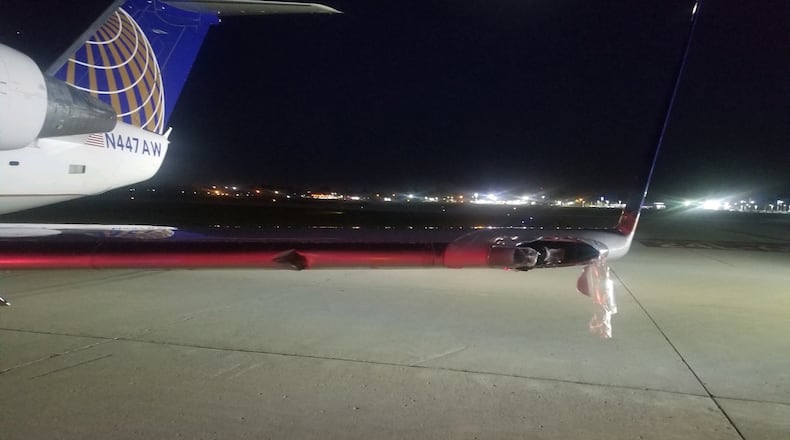“In hindsight, it was traumatic — during the time it really wasn’t that traumatic for me,” said Norm Essman, 70, who was one of about 42 passengers on the flight. “It wasn’t even scary at the time, but it was only scary after you thought about what could have happened — but didn’t happen.”
Air Wisconsin Flight 3818 slid off the runway after landing at the airport at about 7:10 p.m. Wednesday, according to the Federal Aviation Administration.
The Bombardier CRJ200 had about 42 passengers and three crew members aboard and was coming from Dulles International Airport outside of Washington, D.C., according to local officials.
No one was injured in the incident, but the plane’s left wing was damaged after striking some directional signs and lighting, said Tyler McCoy, Dayton’s interim aircraft rescue and firefighting coordinator.
“After landing, during the rollout, the aircraft veered off the runway, into the grass between the runway and Taxiway Echo,” McCoy said. “The plane stopped on Taxiway Echo at Taxiway Gulf.”
When the plane went off the runway, the air traffic control tower sent out an alert about a plane crash to airport rescue and firefighting and police, McCoy said.
Other agencies also were alerted and rushed to the scene, and the initial response was robust due to the seriousness of a plane crash and potential hazards, McCoy said.
These kinds of events are called runway excursions, which occur when an aircraft veers off or overruns the runway surface either during take-off or landing, says the Civil Air Navigation Services Organization.
Runway excursions lead to more runway accidents than all the other causes combined, industry groups say.
Essman, a retired Beavercreek resident, said it was obvious that something went wrong during the landing process, but passengers stayed calm and it was over very quickly, probably in 10 to 15 seconds.
“You could tell once you hit the grass it wasn’t normal,” Essman said. “Once you go cross-country, so to speak, it got a little bumpy.”
But, he said, “Nobody screamed, nobody panicked.”
Essman was flying back to Dayton from Spain, where he spent the last five and a half weeks completing the 500-mile Camino De Santiago pilgrimage.
Essman said he thinks the airplane ended up maybe 40 to 50 yards in the grass.
He said he saw damage to the wing of the plane, and it could have been a disaster if the wing struck the ground.
But Essman said airport staff did a “fantastic job,” and emergency crews were on the scene within minutes.
He said the flight crew was calm, professional and straightforward with passengers.
“It’s only when you figure what could have happened, rather than what did happen ... and since it didn’t happen, we are happy, we are all safe and we all have a story to tell,” Essman said.
Passengers were loaded onto buses and transported to the terminal, said Linda Hughes, the airport’s air service manager.
“It was a blessing that everyone was fine,” she said.
The incident is under investigation by the FAA and the Ohio State Highway Patrol.
It was not immediately clear if the National Transportation Safety Board will investigate the incident as a potential accident.
The agency has investigated about 10 runway excursion accidents and incidents involving commercial carriers at U.S. airports in the last decade.
Runway excursions are a major cause of aviation accidents, and potential factors that can lead to excursions include adverse weather conditions, pilot error, mechanical failure and unstable approaches, aviation industry experts say.
About the Author




